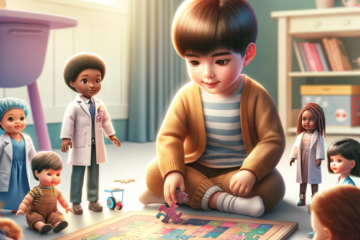In the realm of child therapy, where words might falter and emotions run deep, the unassuming presence of a doll can speak volumes. Beyond mere playthings, dolls become companions, confidants, and mirrors for a child’s inner world. In this delicate dance of healing, the use of dolls holds profound significance, offering a bridge between a child’s thoughts and the therapeutic process.
The Human Touch: Establishing Connection
Imagine a child walking into a therapist’s office, carrying the weight of their worries, fears, and uncertainties. Amidst the unfamiliarity, a doll sits patiently, extending an invitation to explore, express, and connect. In the simplicity of its form, the doll becomes a vessel for trust, a tangible symbol of safety and acceptance. Through gentle interaction, children learn to navigate their emotions, forging bonds of trust with both the therapist and themselves.
Beyond Words: The Language of Play
For children, articulating complex feelings with words can be a daunting task. Here, the language of play reigns supreme, offering a canvas for expression without constraints. As children engage with dolls, they project their thoughts, emotions, and experiences onto these silent companions. In the fluidity of play, they narrate their stories, enact their struggles, and experiment with new narratives. Through this process, children gain insight, develop coping skills, and find solace in the act of creation.
Empowerment Through Representation
In the world of dolls, diversity reigns supreme, with each doll representing a unique identity, culture, or experience. For children navigating issues of identity, self-esteem, or belonging, these representations hold transformative power. Whether through selecting a doll that mirrors their own experiences or crafting a narrative for one unlike themselves, children assert agency, reclaiming ownership of their stories. In this act of empowerment, they learn to celebrate differences, embrace individuality, and cultivate empathy for others.
Healing Through Symbolism
In the hands of a skilled therapist, dolls transcend their material form, becoming vessels for therapeutic intervention. Through guided play, therapists navigate the intricate landscape of a child’s psyche, using dolls as tools for exploration and healing. From role-playing scenarios to creating safe spaces for emotional expression, dolls serve as conduits for catharsis, insight, and growth. In the gentle guidance of a therapist, children learn to confront their fears, process their experiences, and cultivate resilience in the face of adversity.
The Path Forward: Nurturing Resilience
As children journey through the realm of therapy, the lessons learned with dolls become the building blocks of resilience. With each interaction, they develop emotional intelligence, communication skills, and coping mechanisms essential for navigating life’s challenges. Armed with a newfound sense of self-awareness and empowerment, they emerge from therapy not as broken vessels, but as resilient beings capable of weathering life’s storms.
Conclusion:
In the intricate tapestry of child therapy, the humble doll emerges as a beacon of hope, resilience, and transformation. Through its silent presence, children find solace, connection, and healing in the midst of turmoil. As therapists, caregivers, and advocates, let us embrace the therapeutic power of dolls, honoring the profound impact they have on the lives of children around the world. In the gentle hands of a child, a doll becomes more than just a toy—it becomes a symbol of resilience, a testament to the human spirit’s capacity for healing and growth.



0 Comments